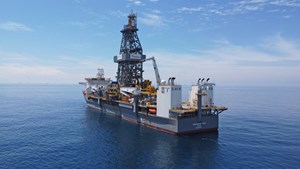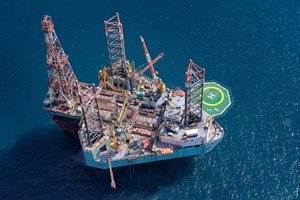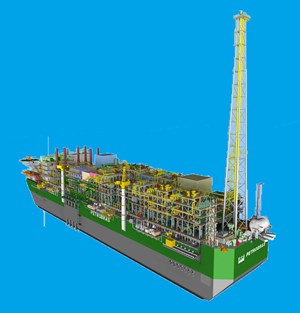First oil
Welcome to one of our more offshore-intensive issues of the year. No less than seven of 11 articles are offshore-oriented, either in terms of technology, market outlook/regulations, or both. For further details, please see the highlights listed at the end of this column. Meanwhile, here, at World Oil, we’re optimistic about the near-term future of the global offshore sector, as well as the long-term picture. And there are some good reasons for that optimism.
Operator motivations. There is definitely a mindset among operators that is leading them to increase activity offshore, and it could produce a surge in this sector, Fig. 1. Here are some of the thoughts shaping their attitudes:
- Global energy demand is rebounding to pre-pandemic levels
- Energy security remains a priority
- Energy pricing continues to be supportive
- Operators see offshore development as offering better returns for longer durations
- The world’s need to use oil and gas will last longer than the more zealous climate change advocates want to admit.

On the first point, there is no argument about the numbers: demand is up, but supply can’t keep pace. In its April 2023 Oil Market Report, the International Energy Agency (IEA) predicts that world oil demand will gain 2 MMbpd in 2023 to a record 101.9 MMbpd. EIA says that due to a widening disparity between regions, non-OECD countries, buoyed by a resurgent China, will account for 90% of this growth.
Meanwhile, on the supply side, IEA says that recent cuts by OPEC+ will push world oil supply down 400,000 bpd by the end of 2023. Furthermore, from March through December, gains of 1.0 MMbpd from non-OPEC+ sources will fail to offset a 1.4-MMbpd decline from the producer bloc. For the year overall, global oil production growth slows to 1.2 MMbpd versus 4.6 MMbpd in 2022. Non-OPEC+, led by the U.S. and Brazil, is driving the 2023 expansion, rising 1.9 MMbpd. OPEC+ is expected to drop by 760,000 bpd.
As regards the second point, various countries continue to scramble, to assure sufficient reliable supplies of gas and oil in the wake of Russia’s February 2022 invasion of Ukraine, particularly in Europe. Net importing countries have re-learned the lesson of how impactful energy can be on national security.
Looking at the third point, oil pricing continues to work in favor of operators undertaking additional offshore development projects. Save for a short period in mid-March, when WTI futures dipped to as low as $66/bbl, crude prices have remained mostly between $70 and $85.
On the fourth item, offshore projects may be more expensive to build than onshore shale, but they can be more profitable at lower prices—due to their larger scale—and thus have lower break-even costs; they can produce for multiple decades; and they generate fewer emissions per barrel, owing to their massive scale.
On the fifth and final point, evidence is mounting that despite the efforts of climate change advocates, it will take noticeably longer to convert the vast majority of the world to so-called cleaner, renewable energy sources. Accordingly, the world will need considerable supplies of oil and gas for a longer time. A perfect example of operator thinking adjusting accordingly is bp’s decision earlier this year to spend more on hydrocarbon development through 2030 than originally planned.
Rig count movements are positive. One simple measurement of improvement offshore is the Baker Hughes Rig Count. As of the March monthly stats, issued in early April, the offshore count outside the U.S. and Canada stood at 228 active rigs. This is its highest level since 228 rigs were working during April 2020. That figure is also 17.5% higher than the 194 units working in March 2022.
Looking at various regions, Africa’s 26 rigs running is the highest level since March 2020, and is 44.4% higher than the 18 units drilling in March 2022. The Middle East, at 44 rigs, is running at its highest level since June 2020, save for the last quarter of 2022, Fig. 2. And activity is 10% higher than a year ago. Also driving the trend is the Asia Pacific region, which had 89 rigs operating in March, which save for this past January, is the highest level since July 2020. It also is 20.3% higher than the level of March 2022.

Not to be outdone, drilling offshore the U.S. in the Gulf of Mexico and Cook Inlet reached a combined 20 rigs in March, the highest figure since March 6, 2020. It’s also 66.7% higher than the 12 rigs running a year ago. Canada continues to hang in at one rig operating offshore Newfoundland & Labrador.
Offshore spending is on the rise. Multiple analysis houses have documented a significant increase in offshore spending, with more to come. Clarksons Research estimates that there was $103 billion of offshore oil and gas CAPEX commitment approved during 2022, up 15.7% from $89 billion in 2021. For 2023, Clarksons predicts a further increase to $107 billion globally. Their analysts say that the 2023 figure is 31% higher than the 2014-2021 average but still 50% below the record high-water mark of $215 billion in 2011.
Similarly, Rystad Energy expects annual, greenfield offshore CAPEX to surpass $100 billion during both 2023 and 2024. The firm says this will be the first time for this to happen in two straight years since 2012 and 2013. Indeed, they think that offshore spending will account for 68% of funds spent on newly sanctioned projects over the next two years, compared to 40% from 2015 through 2018. For the first time, Middle Eastern offshore spending is predicted to top all other regions, amounting to $33 billion, and expected to hit $41 billion in 2025. In South America, Rystad predicts $23 billion of CAPEX offshore Brazil (Fig. 3), with another $7 billion slated in Guyana. Predictably, Norwegian offshore spending should top $21 billion, and another $7 billion is anticipated in the UK North Sea. However, this editor is doubtful about the latter figure, given the manner in which the British government has disincentivized operators with its recent policy moves. Finally, in the U.S., Rystad predicts $17.5 billion of offshore spending, plus another $7.3 billion offshore Mexico.

Contracting activity and dayrates keep building. Our friends on the Evercore ISI analysis team reported on April 15 that global contracting activity accelerated since mid-March, with 15 term contracts announced over a 30-day period. The Middle East, says Evercore, continues to drive up jackup demand, accounting for four of five term contracts in April and 14 of 33 term contracts year to date. Mexico trails in a distant second place, with five term contracts year to date, and demand appears to be picking up in Southeast Asia, where five jackups secured nearly five rig years of work. It should be noted that over the same 30-day period, harsh-environment (H.E.) semisubs accounted for all of the floater contracts announced, with eight units securing nearly six rig years of work.
So, it’s no surprise that analysts at Westwood Global Energy Group said at a presentation in Houston on April 12 that drillship and jackup demand and utilization continue to rise, with active availability running low. The semisub segment, however, remains sluggish in comparison. Again, this editor would re-emphasize the point from Evercore that the H.E. portion of the semisubs remains brisk.
With all the growth in overall rig demand, it’s no surprise that dayrates have been climbing steadily. Westwood’s analysts reported that semisub average dayrates jumped 32% in first-quarter 2023 versus fourth-quarter 2022, due to higher H.E. demand and rates. Meanwhile, jackup rates dipped 2% in the first quarter versus the last quarter, but they are still 23% higher than a year ago. And—take a deep breath—average global drillship dayrates are now in the low $400,000s.
Westwood also provided some additional fascinating statistics. For instance, 79 Upstream FIDs were recorded in 2022, with Europe accounting for 43% of them. The 2023 FID count is
forecast at 70, driven by activities offshore Africa and APAC. In addition, subsea tree demand over the 2023-2026 period is forecast at over 1,300 units, with Latin America accounting for 38%. Westwood says that fixed platform demand is forecast at around 490 units over the forecast period, driven by brownfield projects in the Middle East. In addition, floating production system (FPS) demand is set to total 49 units.
Meanwhile, Clarksons reported that MOPU newbuilding activity is on the rise, with 15 awards in 2022 worth a record $15.6 billion. A further 18 MOPU contract awards of about $20 billion are projected in 2023, including seven FPSOs in South America.
Further development from recent discoveries. The folks at Westwood also believe that recent high-impact discoveries offshore Guyana (Stabroek Block, ExxonMobil), as well as exploratory success offshore Namibia (Orange basin, Shell), represent an upside for contracting opportunities in the latter years of their forecast and beyond. In addition, they listed a number of other candidates, including Suriname (Krabdagu, TotalEnergies), Indonesia (Timpan, Harbour Energy), the U.S. (Blacktip North and Leopard, Shell), Brazil (Pedunculo, Petrobras), Turkey (Caycuma, Turkish Petroleum) and Cyprus (Zeus, Eni).
In summation, all these different indicators point to one thing—a very healthy outlook for the global offshore industry. And these are just the oil and gas indicators. This column hasn’t even delved into the offshore wind activity, although Clarksons did say that offshore wind energy capacity grew 15% during 2022, to 60 GW. Everyone associated with the offshore sector of the upstream industry should be very encouraged through the balance of 2023 and well into 2024.
IN THIS ISSUE
Special focus: Offshore technology. In this month’s lead theme, SLB authors discuss how automated offsets bring a new dimension to drill bit performance evaluation at scale. Meanwhile, authors at DNV, Ocyan and LZ Energia discuss a pioneering engineering project to power rigs with hydrogen. An innovative hydrogen injection scheme aims to accelerate the decarbonization process. Additionally, a 4Subsea author describes how to ensure safe operations on subsea wells using machine vision. Last, but definitely not least, Transocean President and CEO Jeremy Thigpen offers his excellent thought leadership on where the global offshore industry is heading and some of the technology factors accompanying that journey.
Formation evaluation: Coupled prolongation in multi-scale pressure solver for high-contrast heterogeneous reservoir simulation. SLB and Chevron authors describe how efficient multi-scale methods for reservoir simulation require constructing a set of prolongation operators that interpolate solutions from a coarse spatial resolution to a grid resolution. An improved algorithm captures strong contrasts in geological properties better for this objective. Utilizing the new algorithm, operators can obtain better linear and nonlinear convergence rates than previously.
Regional report: Gulf of Mexico. Veteran Contributing Editor Mike Slaton gives readers an unvarnished look at activity in the Gulf, benefitting from his long-term experience covering this region. As Mike reports, the Gulf’s future is full of caveats and short-term affection. There are problems with regulatory interference, weather, pandemics and labor trends. Yet, the region still holds much potential, and it stands to benefit this year and into 2024 from very positive global trends. Accordingly, operators are expected to pursue field developments, much of that in deep water.
ShaleTech report: Permian basin. Another veteran Contributing Editor, Jim Redden, says that the atmosphere in this premier shale basin is very upbeat. At the moment, Permian production is hitting a new high, even amid talk of a looming plateau. Nevertheless, this West Texas and southeastern New Mexico juggernaut is expected to deliver record production of just over 5.6 MMbopd and 22,496 MMcfd of largely associated gas this month, according to the U.S. Energy Information Administration. This represents a year-over-year increase of 567,000 bopd and 2,963 MMcfgd, respectively.

- Advancing offshore decarbonization through electrification of FPSOs (March 2024)
- The last barrel (February 2024)
- Oil and gas in the Capitals (February 2024)
- What's new in production (February 2024)
- First oil (February 2024)
- Subsea technology- Corrosion monitoring: From failure to success (February 2024)
- Applying ultra-deep LWD resistivity technology successfully in a SAGD operation (May 2019)
- Adoption of wireless intelligent completions advances (May 2019)
- Majors double down as takeaway crunch eases (April 2019)
- What’s new in well logging and formation evaluation (April 2019)
- Qualification of a 20,000-psi subsea BOP: A collaborative approach (February 2019)
- ConocoPhillips’ Greg Leveille sees rapid trajectory of technical advancement continuing (February 2019)


